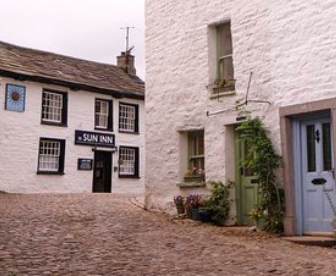
Knitting was once a constant activity for women, men and children in the Upper Dales villages. Whether from farming or lead-mining families, most Dales inhabitants were poor and needed to supplement their income. The solution was to knit at every opportunity. Children were sent to live with cottagers in Dent so they could learn the trade, in an early kind of sweat shop, being cajoled or whipped to knit as quickly as possible. Women knitted as soon as their housework was done. Men knitted on their way to and from work. The Dales knitters were known for their incredible dexterity.
They used a simple tool called a 'knitting stick', a wooden stick that was tucked into a waist belt, which anchored needles and enabled knitters to knit with just one hand. This meant that knitters could do two things at once, perhaps churning butter as they knitted.

The Dent Heritage Centre and Farfield Mill also have displays about the terrible knitters.
Groups of people would often gather in one cottage to save fuel for fires and light, knitting and telling stories or singing as they worked.
Knitters were brought yarn by merchants who also collected the socks, stockings, mittens, hats and jackets they knitted and took them off to market.
Each Dale would have had their own distinctive patterns, a bit like Fair Isle where complex patterns were handed down from family to family. Some of these patterns have been saved and can be seen in the museums or publications such as "The Old Hand-Knitters of the Dales by Marie Hartley and Joan Ingilby.

 RSS Feed
RSS Feed
